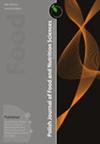传统土耳其乳制品中的微塑料:Ayran
IF 2.3
4区 农林科学
Q3 FOOD SCIENCE & TECHNOLOGY
引用次数: 1
摘要
通过食物摄入微塑料颗粒(MP)与人类的许多健康问题有关。尽管ayran是一种传统且营养丰富的土耳其饮料,但微塑料污染的影响尚不清楚。这项研究通过收集整个生产过程中的样本和用于制作ayran的成分,包括水、盐、奶油、起始培养物、杯子,最后是ayran,来检测微塑料污染对ayran的影响。光学和扫描电子显微镜用于MP的可视化和测量,傅立叶变换红外光谱(FTIR)用于聚合物的鉴定。除发酵剂培养物样品外,在所有检查过的过滤器中均检测到微塑料。MP值最高的样品是盐水(43 MP值/100 mL)、盐(33 MP值/100 g)和取自均化和巴氏灭菌阶段的牛奶样品(26 MP值/100 mL)。此外,在最后一个产品ayran中检测到18 MP数/100 mL污染。尺寸范围为1-150µm的MP占主导地位(37.38%)。乙烯-丙烯是样品中最常见的聚合物(39.30%)。这项研究的结果有助于概述乳制品生产设施中的微塑料污染以及与这种微塑料暴露相关的潜在人类健康风险。本文章由计算机程序翻译,如有差异,请以英文原文为准。
Microplastics in a Traditional Turkish Dairy Product: Ayran
Ingestion of microplastic particles (MP) through food has been associated with a multitude of health problems in humans. Although ayran is a traditional and nutritious Turkish beverage, the impact of microplastic pollution is unknown. This study examined the incidence of microplastic pollution on ayran by collecting samples throughout the production processes and the ingredients used to make ayran, including water, salt, cream, starting culture, cups, and lastly, the ayran. Optical and scanning electron microscope was applied for MP visualisation and measurement, and Fourier-transform infrared spectroscopy (FTIR) for polymer identification. Microplastics were detected in all examined filters except for the starter culture samples. The samples with the highest MP number were salty water (43 MP number/100 mL), salt (33 MP number/100 g), and milk samples taken from homogenization and pasteurization phases (26 MP number/100 mL). Additionally, 18 MP number/100 mL contamination was detected in the last product ayran. MP with a size range of 1–150 µm prevailed (37.38%). Ethylene propylene was the most frequently identified polymer in samples (39.30%). The findings of this study can help provide an overview of microplastic contamination in dairy production facilities and the potential human health risks associated with this microplastic exposure.
求助全文
通过发布文献求助,成功后即可免费获取论文全文。
去求助
来源期刊

Polish Journal of Food and Nutrition Sciences
FOOD SCIENCE & TECHNOLOGY-
CiteScore
4.30
自引率
12.50%
发文量
25
审稿时长
20 weeks
期刊介绍:
The Polish Journal of Food and Nutrition Sciences publishes original, basic and applied papers, reviews and short communications on fundamental and applied food research in the following Sections:
-Food Technology:
Innovative technology of food development including biotechnological and microbiological aspects
Effects of processing on food composition and nutritional value
-Food Chemistry:
Bioactive constituents of foods
Chemistry relating to major and minor components of food
Analytical methods
-Food Quality and Functionality:
Sensory methodologies
Functional properties of food
Food physics
Quality, storage and safety of food
-Nutritional Research Section:
Nutritional studies relating to major and minor components of food (excluding works related to questionnaire
surveys)
-“News” section:
Announcements of congresses
Miscellanea
 求助内容:
求助内容: 应助结果提醒方式:
应助结果提醒方式:


